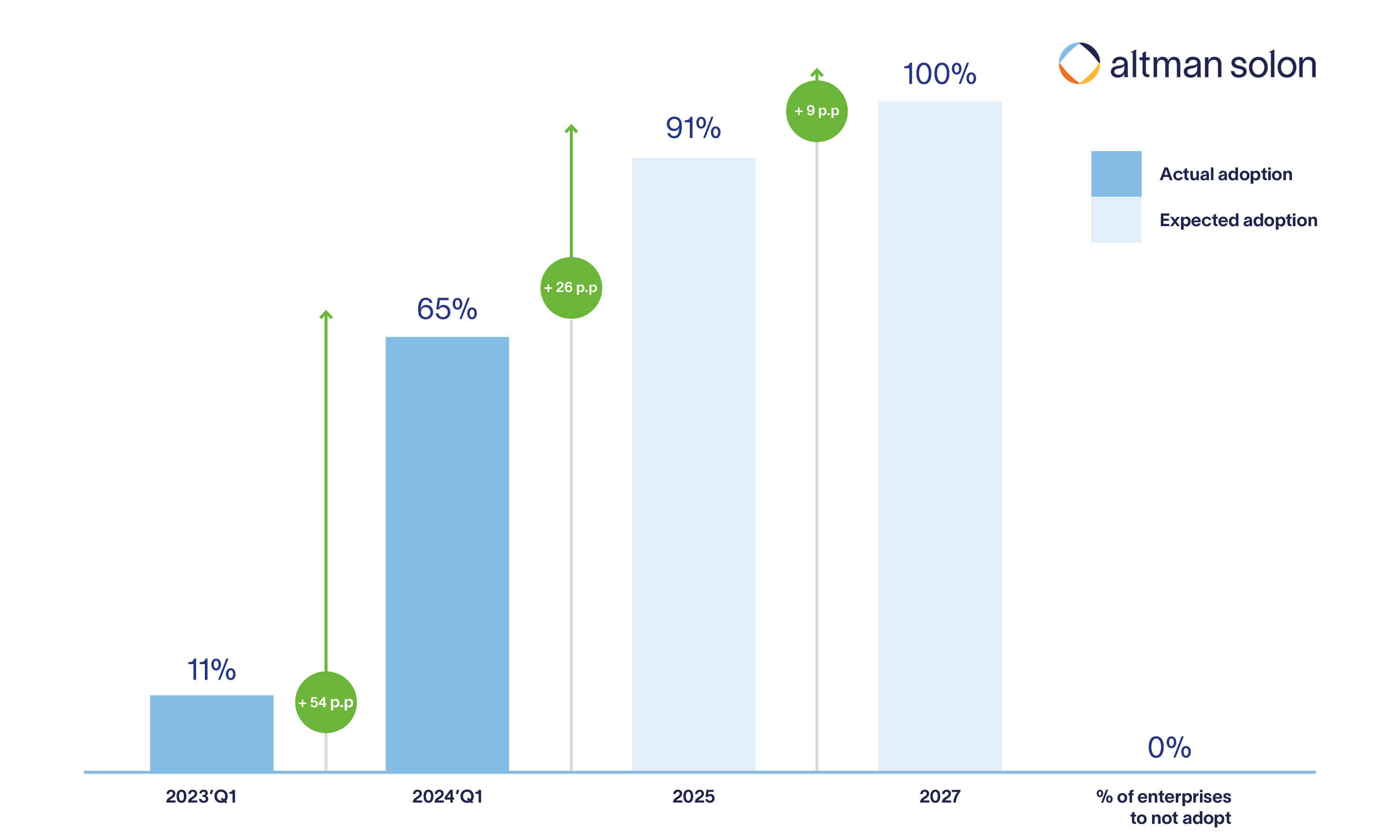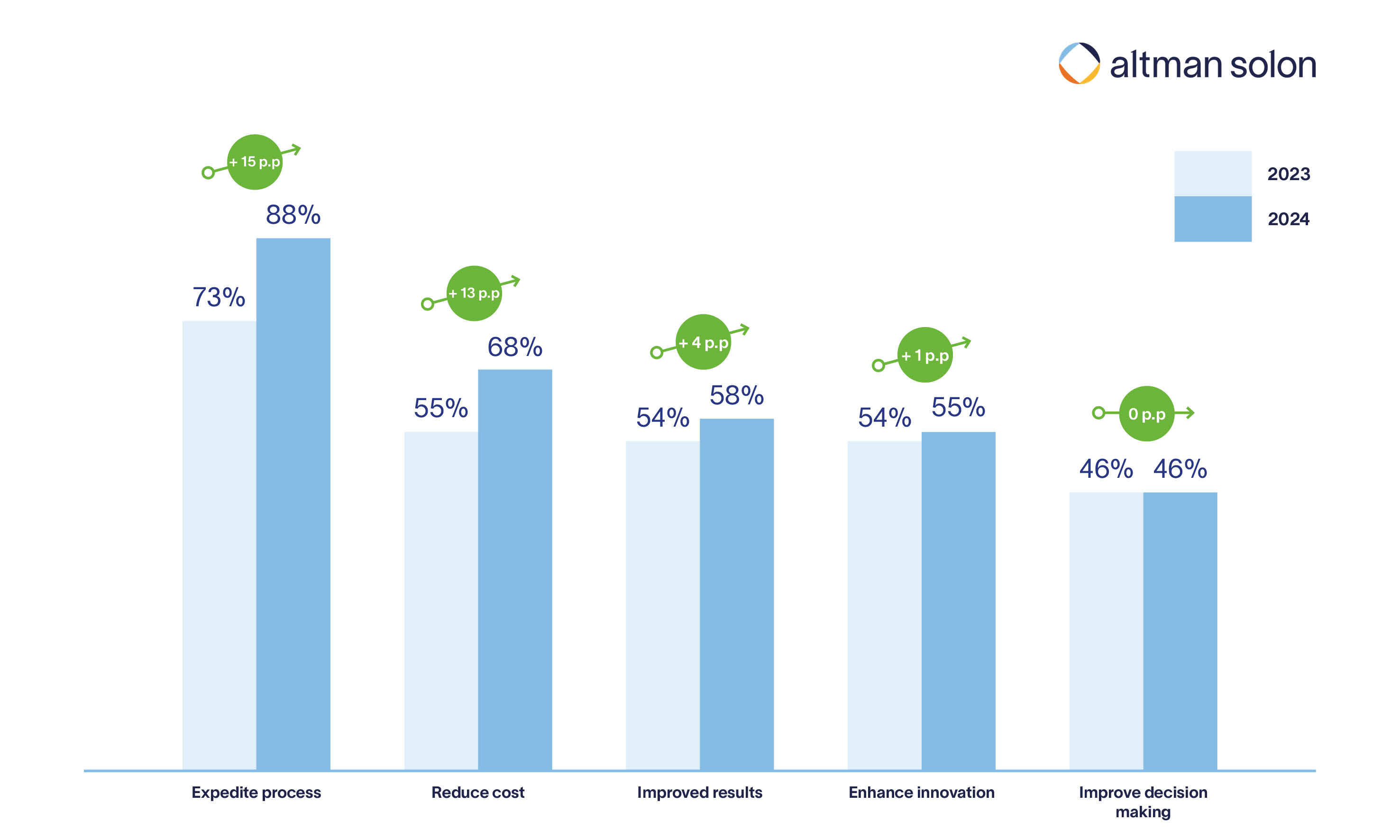In 2023, companies were frantically developing ChatGPT policies and test-driving generative AI tools across specific verticals. Today, these tools have gained considerable traction among companies of all sizes worldwide. Adoption and usage are up, and executives are optimistic about the value these tools can bring to their companies despite lingering concerns about data security. Companies are overwhelmingly using multiple generative AI tools, with some firms leveraging sophisticated AI services. A strong indicator of the growing complexity in enterprise AI is the interest in integrating multimodal enterprise solutions that can process text, image, and video inputs.
Rapid growth in enterprise-grade AI tooling over the past year, with future adoption accelerating
Our clients are pushing for a shift from hourly billing to flat fees for certain tasks, prompting us to rapidly adopt and train generative AI tools to maintain profitability.
CTO, Global Law Firm
Enterprise adoption of generative AI tools has sped up considerably since conducting our survey last year. Findings from our inaugural generative AI survey found that at the beginning of 2023, only 11% of U.S.-based enterprises were using generative AI tools; today, that has increased by over 50 percentage points, with 65% of respondents leveraging these tools in their tech stack. Our findings show that adoption will only accelerate— all firms surveyed expect to adopt generative AI tools in the next three years—suggesting that generative AI is not simply a hype bubble but has the potential to change the way we work in the long term.
Zooming in on use cases, software development continues to lead. Today, 78% of respondents working in software development cite using generative AI tools, up from 23% in 2023. This rapid adoption suggests that generative AI technology might become an industry-standard tool for software developers, transforming how code is created. Use cases in marketing and customer service have also seen respective growth in adoption.
Generative AI tools are valued for speeding up processes and cutting costs, but anxieties around data security have grown
Generative AI tools help us augment customer service workflows, providing quicker and more accurate responses
Head of Technology Office, Global Financial Services Firm
In many respects, 2023 was a test year for generative AI in the workplace, as evidenced by the sharp decline in skeptics. Last year, 68% of respondents struggled to see value in generative AI tooling. In 2024, this number declined to 24% of respondents.
When it comes to motivations for adopting generative AI tooling, the top reasons remain consistent between 2023 and 2024. Respondents cite generative AI's ability to expedite processes through automation (88%), lower costs (68%), and improve results through workflow optimization (58%) as reasons for adoption. In 2024, even more importance was placed on expediting processes (15 percentage point increase) and cutting costs (13 percentage point increase), suggesting that companies have seen tangible benefits in their workloads and expenses thanks to generative AI technologies.
Data residency is indeed a concern for us, as it aligns with data privacy. Compliance with law is a necessity, given our global presence in 120 countries.
Head of Technology Office, International Financial Service Company
However, if the benefits of generative AI are becoming more visible, so are the risks. As the public becomes more aware of gen AI's drawbacks—from the legal risks surrounding training data for large language models to the ongoing problem of hallucinations — security has emerged as a top concern. Seventy-two percent of respondents cite data security as their main worry when implementing generative AI in the workplace, up 40% since last year. This is a big shift from 2023, where "unclear value" was cited as the biggest risk in adopting generative AI.
Most companies use more than one generative AI tool for text and image generation but are interested in adopting a multimodal solution
When looking at tool adoption, over half of respondents use multiple generative AI tools across specific functionalities like text and image generation. As these tools work their way into enterprise functions, we can anticipate a future where IT departments streamline their generative AI portfolio and look to holistic, multimodal solutions that can understand and communicate with media formats ranging from text to visual to audio. Although current adoption of multimodal tools is low—in use among 13% of respondents—some 59% of respondents believe they are "highly likely" to adopt a multimodal solution over the next three years.
Hyperscalers, in parallel, are actively developing multimodal tools and releasing AI assistants like Microsoft's Copilot and AWS's Amazon Q that work across multiple applications. The multimodal AI market size was valued at $1.38 billion in 2023. This market is anticipated to grow from $1.85 billion in 2024 to $19.85 billion in 2032, with a 34.4% compound annual growth rate (CAGR) during the forecasted period.
Integrating generative AI requires balancing opportunities with security risks
The trajectory of generative AI adoption in the enterprise landscape has been remarkable. From a cautious exploration in 2023 to a widespread integration into various business functions by 2024, generative AI tools have swiftly become indispensable assets for companies striving for efficiency and innovation. However, alongside the evident benefits, concerns around data security loom large, signaling the need for thoughtful policies around hosting and deploying AI solutions. Looking ahead, the convergence towards multimodal solutions marks the next phase of evolution, offering even greater versatility and impact across industries. As the generative AI landscape continues to evolve, navigating the balance between innovation and security will be paramount, profoundly shaping the future of work.











